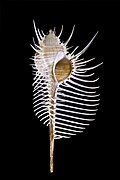New snails
| New snails | ||||||||||||
|---|---|---|---|---|---|---|---|---|---|---|---|---|

Map cone ( Conus geographus ) |
||||||||||||
| Systematics | ||||||||||||
|
||||||||||||
| Scientific name | ||||||||||||
| Neogastropoda | ||||||||||||
| Thiele , 1929 |
The new snails (Neogastropoda) are a species-rich, almost exclusively marine suborder of the Hypsogastropoda within the order Sorbeoconcha of the snails (Gastropoda). They have been found in fossil form for around 100 million years. Overall, the number of new snail species is estimated at around 16,000.
features
The spiral wound housing is mostly right-hand wound and extremely varied. The lower edge is often drawn out in a tubular shape to form a siphon channel. The conditions in the mantle cavity are greatly simplified compared to the Patellogastropoda . The genital organs are separated from the excretory organs. There is usually only one half-feathered gill that is fused with the original central axis on the mantle. Often there is also an extendable snout. The radula usually has a radula with only three teeth per transverse row, a central tooth and two posterior teeth (with the exception of the conoid, here only one poison tooth). Often there is a poison gland that paralyzes the prey. The animals are mostly of separate sexes.
Way of life, occurrence and distribution
New snails are mostly predatory or eat carrion . They occur in almost all seas from shallow water to the deep sea. They live on almost all substrates, from sandy-silty to hard substrates. The new snails include the porcupine snails (Muricidae), the horn snails (Buccinidae) with the whelk and the cone snails (Conidae).
Systematics
The new snails are also referred to in the older literature as Stenoglossa (Schmalzüngler); this name is taken today as a synonym of Neogastropoda. The branch ("clade") of the new snails within the snails , whose linneisch hierarchical rank is left open by Bouchet and Rocroi, is divided by them into six superfamilies.
- Buccinoidea Rafinesque-Schmaltz , 1815
- Muricoidea Rafinesque-Schmaltz, 1815
- Olivoidea Latreille , 1825
- Pseudolivoidea de Gregorio, 1882
- Conoidea Fleming , 1822
- Cancellarioidea Forbes & Hanley, 1851
Individual evidence
- ↑ Cunha RL, Grande C. & Zardoya R. (23 August 2009). "Neogastropod phylogenetic relationships based on entire mitochondrial genomes". BMC Evolutionary Biology 2009, 9 : 210. 10.1186 / 1471-2148-9-210
literature
- Philippe Bouchet & Jean-Pierre Rocroi: Part 2. Working classification of the Gastropoda . Malacologia, 47: 239-283, Ann Arbor 2005, ISSN 0076-2997 .
- Victor Millard: Classification of the Mollusca. A Classification of World Wide Mollusca . Rhine Road, South Africa 1997, ISBN 0-620-21261-6 .
- Winston Ponder & David Lindberg, Towards a phylogeny of gastropod molluscs; an analysis using morphological characters . Zoological Journal of the Linnean Society, 119: 83-265, London 1997, ISSN 0024-4082 .
- Frank Riedel: Origin and evolution of the "higher" Caenogastropoda . Berliner Geoscientific Abhandlungen, Series E, Volume 32, Berlin 2000, 240 pages, ISBN 3-89582-077-6 .
